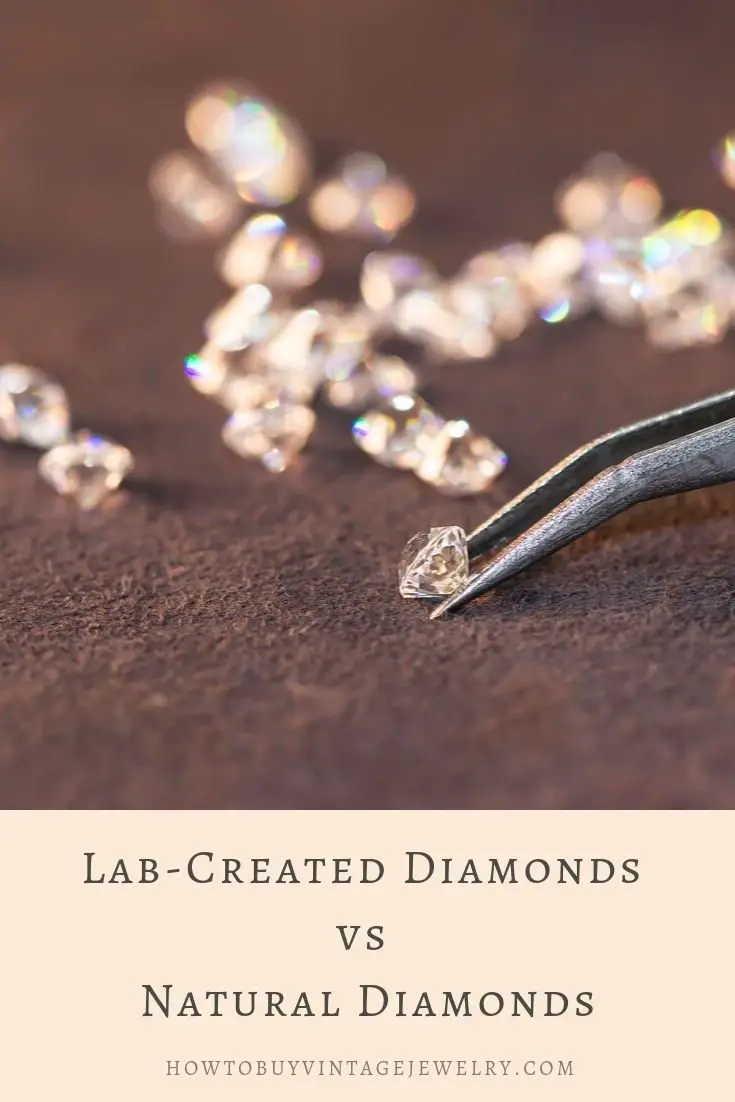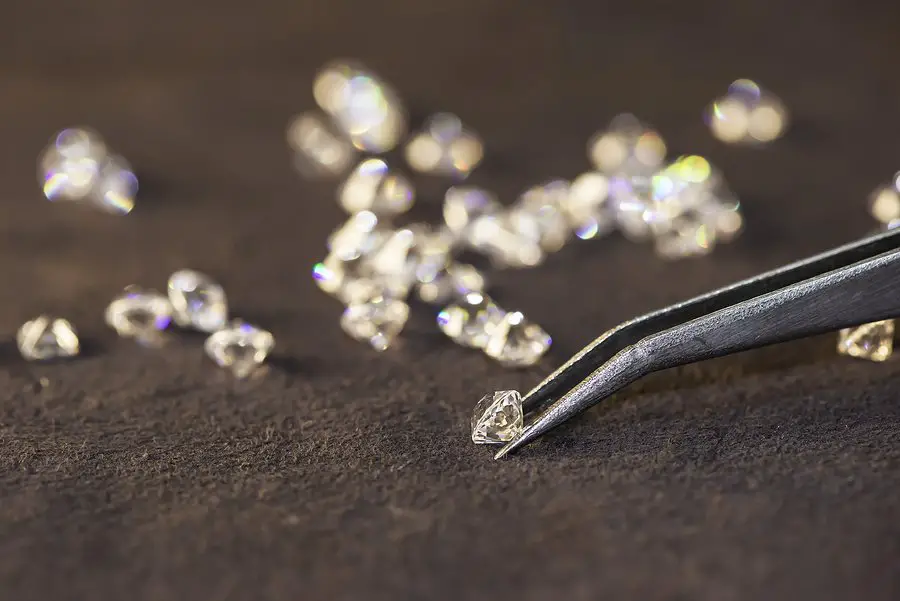Hey There! We may earn a commission from links on this page. This helps support the site and is at no extra cost to you. Thanks!

Lab-created diamonds are also known as “man-made,” “cultured,” "synthetic," or “engineered” diamonds. What they are not is “cubic zirconia.” A CZ is a substitute for a diamond. Lab-created diamonds are real diamonds that share many of the attributes of a natural diamond.
In this article you will learn the similarities and differences of lab-created diamonds vs natural diamonds.
Origins Are Different
Natural diamonds formed deep within the earth a couple billion years ago, give or take. Carbon dioxide buried around 100 miles beneath the Earth’s surface was exposed to heat in excess of 2,200 degrees Fahrenheit and put under about 727,000 pounds per square inch of pressure. The diamonds were then propelled to the surface of the earth by deep volcanic explosions.
Lab-created diamonds are formed by one of two processes: High Pressure-High Temperature (HPHT) and Chemical Vapor Deposition (CVD).
The HPHT process begins when a small diamond seed is placed into carbon and then exposed to temperatures of about 2700 degrees Fahrenheit and pressure of approximately 1.5 million pounds per square inch. The carbon melts around the starter seed and then is carefully cooled to form a diamond.
The CVD process begins when a thin slice of diamond seed is placed in a sealed chamber and heated to around 1500 degrees Fahrenheit. The chamber is filled with a carbon-rich gas, such as methane, and other gases that are ionized into plasma. The ionization breaks the molecular bonds in the gases, and the pure carbon adheres to the diamond seed and slowly crystallizes into a diamond.
Environmental impact is Different
For every carat mined, natural diamonds disturb 100 square feet of land and generate 6000 pounds of mineral waste. Also, mining employs heavy machinery, explosives, hydraulic equipment and the like to extract the diamonds. To give credit where it is due, diamond mining has become one of the most heavily regulated industries, and companies are constantly trying to minimize the effect on the environment.
Lab-created diamonds are significantly less detrimental to the environment. Per carat, they disturb .07 square feet of land and generate 1 pound of mineral waste.
The biggest differences between lab-created and mined diamonds are the amount of water and energy used for mining.
Lab-created diamonds are less expensive that natural diamonds
That’s true, but it does not mean that lab-created are really cheap. They can be from 20% to 30% less expensive than natural. The biggest advantage of the price difference may be that you can purchase a larger diamond on a particular budget.
The reason for the difference in price is not that the quality of the lab-created is less, but that the supply chain is. To get a diamond from the mine to you entails miners, cutters, manufacturers, retailers, etc., which is a long supply chain. Lab-created eliminates the expense of mining and goes through fewer hands—short supply chain.
Lab-created diamonds are Chemically identical to natural diamonds
Lab-created diamonds consist of carbon atoms arranged in the characteristic diamond crystal structure and, therefore, exhibit the same chemical and optical properties, i.e., the same fire, scintillation and sparkle. They cannot be distinguished from natural diamonds by eye or even by loupe. Only specialized equipment is able to detect microscopic differences.
Lab-created diamonds are graded exactly the same as natural diamonds
Regardless of the certifying organization, each diamond (lab-created and natural) is graded independently by several gemologists. The individual grades are compiled and analyzed to determine the final grade. The gemologists judge the diamond by color, cut, clarity, color, and carat.
Three of the organizations that grade both lab-created and natural diamonds are:
How to choose between The Two
The bottom line is that your choice depends solely on what you prefer.
A natural diamond certainly has about it a long-held significance or mystique. It is a miracle of nature, unlike anything else on earth, and denotes luxury. It took billions of years to form and that may be more meaningful to you than a diamond that was created in a few weeks.
Then there is a growing contingent of people who place a great emphasis on protecting our environment and celebrate the wonders of and value modern technology. And then there’s the price.
It’s not a competition. All diamonds represent love. All are beautiful. Select the one that speaks to your heart.
Go to the James Allen website to see glorious collections of both lab-created and natural diamonds.
If you have any questions, please leave them in the comments below, we will do our best to help you out.
Happy Diamond Hunting!
Andrea


I think that it is almost impossible to get regular diamond ring without it being remaked or reshaped in some laboratory. Diamonds are very expensive and for most everyday customers, it is mission impossible. Lab-created diamonds are good as natural ones. The only difference is that it might have been cut or has smaller portion of the original stone in the ring itself.
Lovely website by the way.
Hi Andrea, This is a very interesting post and I have to admit that it has educated me, I was aware of the fact that you could buy real or natural diamonds and there are also synthetic or man-made diamonds, I do realize that the majority of people would prefer the real thing rather than man-made, but that’s if they can afford the price difference, however, I was unaware of the cost to the environment, which after reading this post has made me aware of the fact that this should also be taken into consideration when deciding which diamond to buy, thank you for this information.
Hi Russ, yes the environmental impact is a big consideration to make when making the decision to go natural or man-made. The other option is to look for an alternative gemstone to a diamond. Thanks for stopping in!
Hello Andrea,
Thank you for this informative post.
Until now, I always thought that lab-grown diamonds were inferior and could easily be identified by a jeweler using a loupe. I didn’t realize that they are exactly the same. That said, you did say microscopic differences can be detected with special equipment. Can you provide any more detail on that?
There is something alluring when you hear natural diamond. It’s almost as if natural is a way of saying anything else is inferior. I’m sure it’s a marketing thing but it works well in my mind for some reason.
I’m big on renewable energies and recycling (although not as big as I should be) and can see the value in going with lab-grown option.
Thanks again,
Scott
Hi Scott, structurally both lab-grown and natural diamonds are the same and are impossible to tell apart with the naked eye. You can learn more about how special equipment can tell the two apart in this article:
https://www.popsci.com/how-tell-apart-lab-grown-and-natural-diamonds/
Natural diamonds are precious materials of nature that are rare and as such has attracted a lot of interest from the world and they are usually in high demands but then, since the turn of the world, there have been constant updates and now, lab-created diamonds are almost the same as natural diamonds. But left to me, I will surely prefer getting a natural diamond to getting any other type of diamond. Thanks
Your article about man-made diamond and natural diamond are easy to understand. Thanks for your sharing, I learned a lot more about diamonds now.
So if you are presented with two different types of diamonds without labeling which is which. Would you be able to identify the types of diamonds? Is it easy to differentiate the diamonds just by looking at it? How would you know the diamond is man-made or natural if you were not told.
Hello 🙂 You can only tell the two apart with special equipment. The naked eye will not be able to tell the difference between a lab-created or mined diamond.
You make some really interesting and compelling points I must say. Some people might prefer naturally mined diamonds to their lab created counterparts for the vast significance it holds. But then, when the environmental factors are brought into perspective, you find that lab created diamonds are actually more suitable. For me personally, the difference aren’t that much and with more emphasis on the environmental factors, I prefer the laboratory made diamonds. Thanks
Your comparison is awesome in both Lab created Diamond and Natural diamond. Now I know that the biggest differences between lab-created and mined diamonds are the amount of water and energy used for mining. There is something alluring when you hear natural diamond. It’s almost as if natural is a way of saying anything else is inferior. I’m sure it’s a marketing thing but it works well in my mind for some reason. Thanks again,
Thanks for stopping in Parveen 🙂 There is an allure to a natural diamond to me as well, I think it is because it was formed in the earth over thousands of years. However, I do think the environmental impact of mining diamonds makes a lab-created diamond a worthy investment.
Hi Andrea, thanks for a lesson in diamonds. I first heard about production of diamonds in college when I studied Chemistry and always wondered what was so special about them. I always thought that lab created diamonds were very inferior to natural ones and only the top end natural ones could be bought and worn as the real thing. I only have one diamond and that is in my engagement ring. It is cute and shiny. I am okay with it whether it was lab made or not. I was glad to know more about diamonds though. Thanks
Thanks for stopping in!